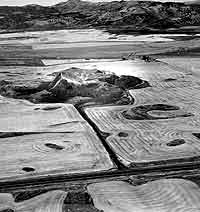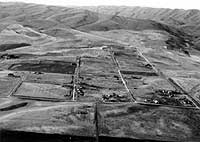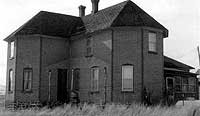|
Page
88
|
|
Oscar Sonnenkalb wrote of Chester Call that he was:
|
Early settlers came to the Chesterfield area in 1881 and 1882 and built crude dugout shelters along the bottom land of the Portneuf River. The community was dealt a major setback in 1882, when the Oregon Short Line was built through Bancroft to the south, but the proponents of Chesterfield refused to believe this would doom their town.
in
Wyndham, editor, (1986), Famous Potatoes |
Mormon Church authorities from Cache Valley visited Chesterfield in November, 1883, and advised that a townsite be laid out on high ground east of the Portneuf River flood plain. The townsite was a mile long and3/4 mile wide, and was divided into 10 acre blocks that would then be subdivided into four equal lots of 2.5acres. The settlers followed the pattern of Salt Lake City and laid out a city with streets ninety-nine feet wide, with sixteen foot sidewalks at each side. The streets of Chesterfield were wider than the boulevards of New York.
The site was named Chesterfield in memory of Chesterfield, England,and to honor Chester Call. Some families chose home sites in the village, but many did not. Prosperity came slowly, if at all.
Most of the buildings of Chesterfield were built between 1884 and 1904. By the mid-1890s 50 families had moved into the village. A kiln was built east of town to fire the bricks used to build new church buildings. By 1900, Chesterfield had 418 people on its ward records. A few brick homes were built, the pride of the community. The agricultural Depression of the 1920s and 1930s was the final blow to the city of Chesterfield.
 |
 |
 |
|
(left) Aerial view looking north at Alexander Crater, a cinder cone on the Oregon Trail in Gem Valley. The Chesterfield Range is in the background,(September, 1984). (center) Aerial view looking north at the Chesterfield townsite. The ambitious town plat was never fully subscribed and houses were not built on many of the possible sites. The Moses and Mary Vashti Call Muir house is at the lower right. The Chesterfield Range is in the background, (May, 1992). (right) Moses and Mary Vashti Call Muir house, Chesterfield, (April, 1996). This is the oldest brick house in the Chesterfield area, built in 1888. In Mormon style of the time, it has two front doors. |
||